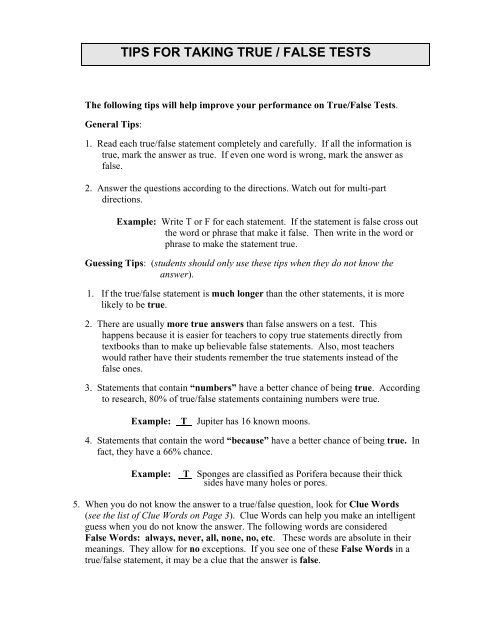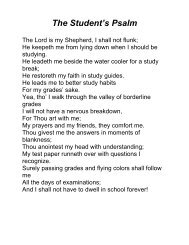Tips for Taking True/False Tests (PDF) - The Excel Program
Tips for Taking True/False Tests (PDF) - The Excel Program
Tips for Taking True/False Tests (PDF) - The Excel Program
You also want an ePaper? Increase the reach of your titles
YUMPU automatically turns print PDFs into web optimized ePapers that Google loves.
TIPS FOR TAKING MULTIPLE-CHOICE TESTS<strong>The</strong> following tips will improve your per<strong>for</strong>mance on Multiple-Choice <strong>Tests</strong>:1. Read each multiple-choice question carefully two times.2. After you have read the question, cover the answer choices. Try to anticipate thecorrect answer. <strong>The</strong>n look at the choices to see if your answer is there. If not, tryto select the best answer.3. On a multiple-choice test that has four answer choices, you have a 25% chance ofbeing correct even by wild guessing.Example:A four-sided shape is:a. a squareb. a trapezoidc. a rectangle* d. all of the above4. <strong>The</strong> most important thing to remember when taking a multiple-choice test is toalways read all the choices be<strong>for</strong>e marking the answer. <strong>The</strong> most commonmistake that students make is choosing the first answer that seems to be correct.<strong>The</strong>y do not read all the answer choices. Beware, sometimes there may be abetter answer or the answer could be “all of the above”. Also watch out <strong>for</strong>throat grabber answer choices.5. If either “all of the above” or “none of the above” suddenly appears as one of theanswer choices on the test, be extra careful, it could be a clue that it is the correctanswer. (If used as an answer choice in almost every question, it is not a clue)6. Be alert <strong>for</strong> the words “NOT”, “EXCEPT” or “LEAST”. You must select theanswer that is most wrong.Example:Which of the following is not a part of a flower?a. petal* b. frondc. sepald. stamen
7. Do not read too much into the questions. Do not keep thinking, “what does theteacher really mean...?”8. <strong>The</strong> key to taking a multiple-choice test is the ability to eliminate, or narrow downthe choices. By doing this, you are using deductive reasoning. This involvescarefully reading the question and each answer choice and then logically eliminatingone or more of the choices. Use your common sense and your backgroundknowledge. <strong>The</strong>se are considered intelligent guesses. If you are allowed to write onthe test paper, you should cross out wrong answers.9. Some students get confused when they see a multiple-choice question that hasmultiple options <strong>for</strong> each answer choice. <strong>The</strong> strategy <strong>for</strong> handling this type ofquestion is to pretend that all the options are true/false statements. Write T or F nextto each choice. <strong>The</strong> correct answer will be all the choices that are true.Example:Which of the following are characteristics of a bird?I. all have wings.II. all lay eggs.III. all can fly.IV. all have beaks.a. I and III* b. I, II and IVc. I, III and IVd. all of the above10. Even when you study thoroughly <strong>for</strong> a multiple-choice test you may still not knowall the answers. When you do not know the answer you should look <strong>for</strong> clues.To use clues you must know what to look <strong>for</strong> and learn to think like the test-writer.Some clues give away the answer. Other clues help you narrow down the answerchoices so you can make an intelligent guess. (Clues are usually not found onstandardized tests like the SAT, CTBS, ITBS, etc.)
MULTIPLE-CHOICE CLUES1. GIVEAWAY CLUE - Look to see if the exact word or phrase or a similar word orphrase is used in both the question and one of the answer choices. In addition, checkto see if a word or phrase in the question has the same meaning as a word or phrase inone of the answer choices.Examples:Rocks <strong>for</strong>med by sediment and deposited in layers on the ocean floor are called:a. igneous rocks.b. metamorphic rocks.* c. sedimentary rocks.d. none of the above<strong>The</strong> belt of volcanoes called the Ring of Fire is located in the area:* a. that nearly circles the Pacific Ocean.b. below the southern tip of Africa.c. to the north of Iceland.d. none of the above.2. A or AN CLUE - Look to see if the question ends with the words “a” or “an”. <strong>The</strong>word “a” is used be<strong>for</strong>e words that begin with consonants and the word “an” is usedbe<strong>for</strong>e words that begin with vowels (a, e, i, o, u, and sometimes y). <strong>The</strong> test-writercan eliminate this clue by using a(n) in the test question.Examples:<strong>The</strong> <strong>for</strong>m of government in which the ruling power belongs to a few persons is an:a. monarchy.* b. oligarchy.c. democracy.d. plutocracy.A cone-shaped hill of sand and gravel is called a:a. esker.b. augite.c. oxime.* d. kame.3. SINGULAR OR PLURAL CLUE - Check to see if the test-writer used grammaticalconsistency between the question and the correct answer. When an answer choiceshould be singular all the other answer choices <strong>for</strong> that question should be singular. Ifthe test-writer inadvertently mixes in plural with singular answer choices or vice versa,this provides a clue.
Example:A paleontologist is:a. a person who works at “Jurassic Park”.* b. a person who studies life on the earth in past geologic times.c. a scientist who studies life on other planets.d. a scientist who is pale.10. THE LONGEST ANSWER CLUE - When you do not know the answer and can notfind any other clues, the choice that is much longer and more detailed than the otherchoices may be a good guess.Example:<strong>The</strong> limpet:a. lives in dry places.b. is a leech.* c. has a tent-shaped shell and moves by gliding on mucus produced by its thick,fleshy foot.d. has six legs.11. THE “C” CLUE - Research has shown that in four item multiple-choice questions,“C” is the answer slightly more often than the other choices. <strong>The</strong> letter “B” is thesecond most popular answer. This clue should be used only after you have searched<strong>for</strong> all other clues. (This clue is useful only when taking teacher-made tests-notstandardized tests like the SAT, CTBS, etc.).
LEARNING TO MANAGE TIME WISELY ON TIMED TESTS<strong>The</strong> following tips will help you work more effectively and efficiently on bothclassroom and standardized timed tests:PENCIL TIPS (<strong>for</strong> machine scored tests)1. Pencil Type- You must use a #2 pencil because the lead is softer and themachine which scores the tests picks up the carbon from a #2 pencil mark onthe answer sheet better than it would from a #1 pencil which has much harderlead.2. Pencil Point- Your pencils should have slightly dull points. <strong>The</strong> more surfacearea the point of the point of the pencil has, the fewer strokes you need tomake to fill in the ovals on the answer sheet. Also a slightly dull point is lesslikely to break.3. Eraser- Your eraser should be large and clean. Erasing takes longer when youuse a dirty eraser. Also a worn down eraser may tear the answer sheet whenyou erase.KEEPING YOUR PLACE TIPS1. Test Placement on Desk- (when using a test that has a separate answer sheet)<strong>The</strong> right-handed student should fold the test booklet to theappropriate page and then place it on the left side of the desk.<strong>The</strong> answer sheet should be put on the right side of the desk.<strong>The</strong> left-handed student should reverse the arrangement describedabove.When the desk is very small the student should put the folded testbooklet on the desk. <strong>The</strong> separate answer sheet should be placed ontop of the booklet and moved down the page as the questions areanswered.2. Keeping Your Place on the Test-Be<strong>for</strong>e marking any answers always check to see how the numbersof the test questions are arranged on the page:Across the page or down the page?Front only or front and back of page?
To keep your place on the test put your finger on the test questionand your pencil on that same number on the answer sheet.Double check every 5 to 10 questions to make sure that the numberyou are marking on your answer sheet is the same number as the testquestion you are answering. Not checking your numbers can causeyou to skip a number and then get all the rest of the test questionswrong.MARKING THE ANSWER TIPS1. Mark from the inside of the oval to the outside of the oval.2. Mark quickly and neatly.3. Mark dark.4. Try to fill in about 80% of the space. Don't be compulsive about filling inevery speck. If you wish, you can fill them in more thoroughly when youhave finished taking the test and still have extra time.5. Completely erase any answers you decide to change. Erase all stray marks onthe answer sheet. Also, if your mark goes way out of the space, be sure toerase or the machine may mark it wrong. <strong>The</strong>re is no need to erase if youonly go a little out of the space.CLOCK OR WATCH TIPS1. Don't be a clock-watcher. This wastes valuable test time and may make youeven more nervous. Check the clock when you are about half way throughwith the test questions. <strong>The</strong>n pace yourself. Speed up or slow downdepending on the time remaining.2. Don't panic when time is running out. Use the remaining time wisely. Workcalmly, quickly and carefully on as many questions as you can. If you stillhave not finished then take the last minute to "wild" guess. You cannot getquestions right if you don't answer them!SPEED TIPS1. Be sure to read all written test directions and listen to all oral directions carefullyso that you will respond in the correct way the first time.2. Be<strong>for</strong>e starting to answer the test questions, quickly skim over the entire test tosee what the test covers and the types of questions you must answer. Moststudents will begin the test immediately. But they will also discover too late (with5 minutes left) the 30 point essay question on the last page.
3. If the test is divided into different sections, e.g. (true-false, multiple-choice,matching, essay, etc.) do the easier sections first.4. Go through the entire test doing the easiest questions first. <strong>The</strong>n go back and trythe more difficult ones.5. When you skip difficult questions on the test always be sure to mark them. Putthe mark next to the skipped questions on the test, on the answer sheet or write thenumbers of the skipped questions on scratch paper. This way you will rememberto answer them later and be able to locate them quickly.6. Don't make careless errors by rushing too fast. You must balance speed withaccuracy.7. Don't get upset if you don't finish a section of a standardized test. If you do it maycause you to score lower on the other sections of the test.



